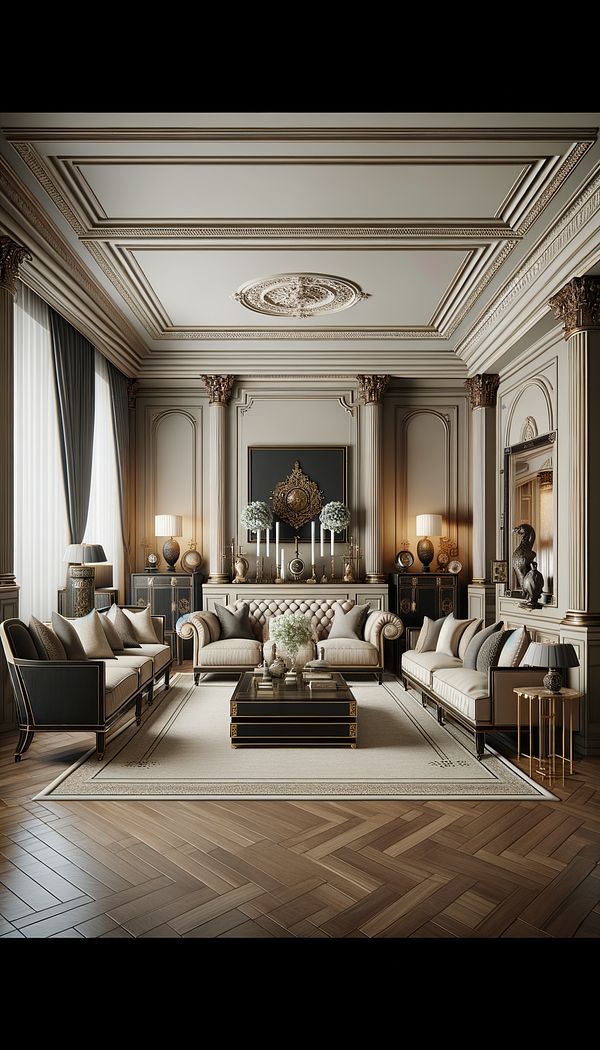What is Classic Style?
Classic Style is a timeless, elegant, and harmonious design philosophy that emphasizes symmetry, sophistication, and functionality.
Description
Classic Style in interior design is characterized by its timeless elegance and commitment to symmetry, functionality, and sophisticated aesthetics. It draws inspiration from the architectural and interior design elements of ancient Greece and Rome, as well as European decor from the 18th and 19th centuries, blending them into a design that exudes warmth, comfort, and grandeur.
At the heart of Classic Style is the use of high-quality materials like wood, marble, and natural fibers, along with a muted color palette that often includes shades of white, beige, gold, and dark wood tones. Furniture pieces are typically substantial and ornately detailed, often featuring dark wood finishes and elegant upholstery. Decorative elements such as mouldings, cornices, and columns play a significant role in enhancing the architectural beauty of a space, while artwork and sophisticated decorative objects add a touch of personal elegance.
This style is not just about the visual appeal; it also focuses on creating a balanced and harmonious living environment. The layout and arrangement of furniture and decorative items follow a symmetrical pattern to evoke a sense of order and tranquility. Attention to detail is paramount in Classic Style, with every element carefully chosen to contribute to the overall cohesiveness of the design.
The timeless nature of Classic Style means it can blend well with modern elements in what is often referred to as 'transitional design.' This allows for the incorporation of contemporary comforts and technologies while maintaining the aesthetic and philosophical tenets of classicism.
Usage
Classic Style can be seen in a variety of environments, from grand, stately homes to elegant apartments and public spaces such as hotels, museums, and government buildings. It’s appreciated for its ability to create a luxurious, yet inviting atmosphere, making it a popular choice for those looking to infuse their spaces with timeless elegance and sophistication.
FAQs
-
How does Classic Style differ from modern interior design styles?
Classic Style stands out from modern interior design styles through its emphasis on symmetry, ornate detailing, and the use of traditional materials like wood and marble. While modern design leans towards minimalism, clean lines, and industrial materials, Classic Style focuses on warmth, luxury, and the finer details that convey timeless elegance.
-
Can Classic Style be combined with other design styles?
Yes, Classic Style can be effectively combined with other design styles, especially in a ''transitional design'' approach which blends classic and contemporary elements. This allows for the integration of modern convenience and classical elegance, providing a unique and customized aesthetic.
-
Is Classic Style expensive to achieve?
Creating a Classic Style interior can be more costly than some other styles due to its emphasis on high-quality materials and detailed craftsmanship. However, it's possible to achieve this look on a budget by focusing on key elements, such as rich color palettes and symmetrical layouts, and investing in timeless pieces over time.
Practical Application
To achieve a Classic Style interior, start with a neutral color palette and add rich, warm tones through furniture and decor. Focus on incorporating symmetrical arrangements and high-quality materials like wood, marble, and natural fibers. Pay attention to architectural details and consider adding elements such as decorative mouldings or columns to enhance the sense of sophistication. Finally, select ornamental and functional pieces that contribute to a luxurious and harmonious living environment.
-
Architectural Elements199 articles
-
Design Styles478 articles
-
Furniture Types599 articles
-
Decorative Techniques322 articles
-
Color & Patterns154 articles
-
DovetailDovetail is a type of interlocking joinery technique used in woodworking.
-
JacobeanJacobean refers to the styles of furnishings and design popular during the reign of James I of England.
-
CrochetingCrocheting is a versatile textile art form involving the interlocking of loops of yarn, thread, or other materials using a crochet hook.
-
CabochonA cabochon refers to a stone that has been polished and shaped without faceting.
-
EtagereAn etagere is a piece of furniture consisting of a series of open shelves for displaying or storing items.
